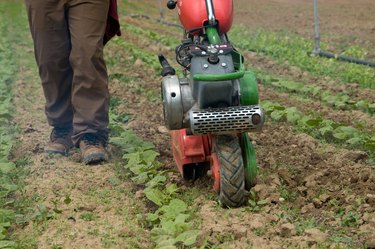
Cultivating a garden bed where intensive flower or vegetable plantings are grown prepares the area for planting. The moving tines of a mechanical tiller break up soil clumps, improve aeration and mix in any fertilizer or organic matter amendments before planting. Ideally, till areas that are not full of existing weeds, as you risk clogging the tines, burying weed seeds or chopping up roots to create more weed sprouts.
Weed Size
Video of the Day
The numerous tine blades on a tiller will cut and chop the garden's topsoil to a depth of 2-to-8 inches, depending on the machine's power, weight and tine length. Small annual weeds that sprout on the surface will be chopped and buried during the tilling event. The killed weeds will decompose and add nutrients and humus to the garden. Larger weeds, however, can become long-stemmed, or very fibrous. These weeds can toughen the soil profile and cause the tiller blades to skip and jump rather than burrow and overturn the soil surface. Tall or extensive, spreading weeds need to be pulled up before tilling, including tree seedlings. Otherwise the stems will clog the tines or prevent the tines from consistently reaching the soil.
Video of the Day
Weed Type
Annual weeds -- those that sprout and die within one growing season or calendar year -- are much easier to plow over with a tiller, especially when they are young and fleshy. Annual weeds develop a small taproot or shallow, fibrous root system that is easily disrupted and killed. Perennial weeds are more difficult to control, as they sprout back repeatedly from an extensive root system or deep bulb. Perennial weeds that have running roots or stolons need to be removed before tilling. Chopping up perennial weed roots creates lots of root cuttings -- each potentially sprouting into new plants and exacerbating the weed problem in the garden.
Seed Issues
If any weeds have flowered and display seeds of any developmental stage, remove them before tilling. Topsoil is full of seeds already, and one potential drawback to tilling is that you bring dormant weed seeds up from the depths to the surface where they can germinate. By pulling out weeds with flowers and seeds, you diminish the likelihood that you are burying or scattering any new seeds into the garden's soil profile.
Timing
Till the garden when the soil isn't frozen at any depth and the soil is slightly moist but never compacted nor soggy. A crumbly textured soil makes the ideal tilling medium. In weed-covered areas, the soil may not dry up after it rains as quickly and remain too mucky to till well. Pulling up weeds allows air and sunlight to dry the soil better. Do not till the soil -- weed-covered or not -- when the soil is wet. Your foot traffic compacts the wet soil, and the moving tiller tines can not as effectively move and break up muddy clumps as they churn through the dirt.
- University of Vermont; Tilling the Garden and Other April Gardening Tips; Leonard Perry
- Gazette Net; Should Your Garden Be a No-Till Zone?; Edward M. Eveld; April 15, 2011
- Learn2Grow; Incorporating Amendments to Your Lawn Soil; Carol A. Crotta
- Learn2Grow; A French Lesson in Intensive Planting; Linnea Thornton